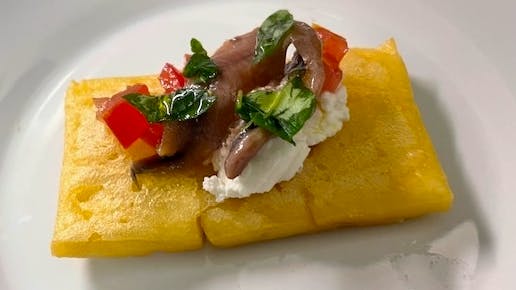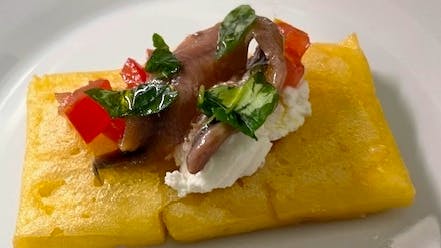

In one week, we’ll be celebrating World Vegetarian Day! To mark the occasion, we’re teaming up with our Cesarina Lunia from Capannori to share a delicious plant-based recipe perfect for a snack or appetizer with friends: chickpea squares.
This dish is a staple of traditional Italian “cucina povera” (peasant cuisine), known for its firm, compact texture. Naturally vegetarian and gluten-free, it’s a healthy, protein-rich, and all-natural alternative for those looking to eat well without sacrificing flavor. Incredibly versatile, it can be enjoyed on its own or filled in various ways. A classic version pairs it with ricotta, anchovies, cherry tomatoes, and basil, while a richer take includes burrata, pancetta, and asparagus tips.
Chickpea flour has been appreciated since ancient times in both Greece and Rome, where it was commonly used in everyday cooking. Today, it remains a key ingredient in many Italian recipes, particularly in Liguria and Tuscany.
Although chickpea flour is widely available in supermarkets, for a truly authentic experience, it’s easy to make at home. The process is simple: grind dried, hulled chickpeas until you get a fine, flour-like powder. This flavorful and versatile flour can be used on its own or combined with other flours to create both sweet and savory dishes.
If you're curious to discover more chickpea-based recipes, you can find them in the Cesarine’s cookbook, including farinata with purslane and vegan chickpea patties.

Chickpea polenta
With a rich flavour and firm texture, chickpea polenta is ideal for anyone seeking a nutritious, gluten-free option.
Ingredients
- 900 ml of water
- 300 g of chickpea flour
- Extra virgin olive oil, to taste
- Salt, to taste
- 4–6 cherry tomatoes
- 4–6 teaspoons of ricotta
- 4–6 fresh basil leaves
- 4–6 desalted anchovy fillets
Method
- Gradually dissolve the chickpea flour in warm water, mixing well.
- Place the mixture over low heat and cook slowly, stirring often, until it thickens and begins to boil.
- Pour the mixture onto a plastic or steel tray, spread it into a rectangular shape, and let it cool in the refrigerator.
- Once set and cold, cut it into rectangles and sear them in a non-stick pan with a small amount of oil until golden.
- Top each rectangle with a spoonful of ricotta, lay an anchovy fillet on top, and finish with a few pieces of fresh tomato.
- Finish with a drizzle of olive oil, a pinch of salt and pepper to taste, and, if you like, a fresh basil leaf.
Variation: use burrata, pancetta, and asparagus tips instead
World Vegetarian Day
World Vegetarian Day, celebrated annually on October 1st, is an international observance established in 1977 by the North American Vegetarian Society and officially recognized in 1978 by the International Vegetarian Union. The day aims to raise public awareness about the ethical, environmental, and health benefits of a meat-free diet.
Being vegetarian means abstaining from the consumption of meat and animal-derived products. This choice is often motivated by ethical reasons, such as respect for animal welfare; environmental concerns, aiming to reduce ecological impact; and health benefits, including lowering the risk of cardiovascular diseases, diabetes, and certain types of cancer.
Vegetarianism Around the World
Globally, it is estimated that about 22% of the world’s population—approximately 1.5 billion people—follow a vegetarian diet. This trend is influenced by cultural, religious, environmental, and health factors that vary widely across regions.
India leads the world with the highest proportion of vegetarians, ranging from 31% to 42% of its population, largely due to cultural and religious traditions that encourage plant-based eating. Other countries with significant vegetarian populations include:
- Taiwan: around 13% of the population identifies as vegetarian, influenced by Buddhist practices and growing health awareness.
- Israel: approximately 13% of Israelis follow a vegetarian diet, reflecting increasing interest in animal welfare and sustainability.
- Italy: roughly 10% of the population is vegetarian, with a strong tradition of Mediterranean cuisine that easily supports plant-based choices.
- Germany: about 9% of Germans identify as vegetarians, reflecting growing environmental consciousness.
- United Kingdom: around 8% follow vegetarian diets, supported by a vibrant vegetarian food culture.
- United States: estimates suggest about 5% to 6% of Americans are vegetarian, with many embracing plant-based eating for health and ethical reasons.
At the lower end of the spectrum, some countries have relatively small vegetarian populations, often due to dietary traditions centered on meat consumption. This global diversity highlights how vegetarianism is both a personal choice and a reflection of broader social and cultural trends. As awareness of sustainability and health continues to grow, more people worldwide are exploring plant-based diets.
